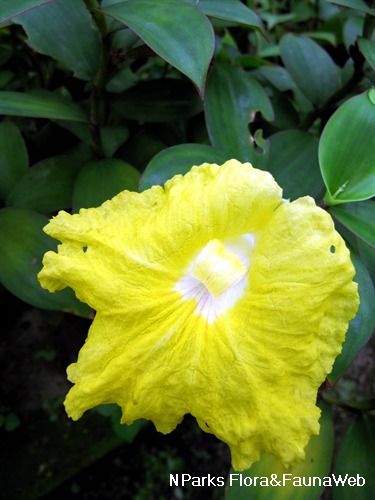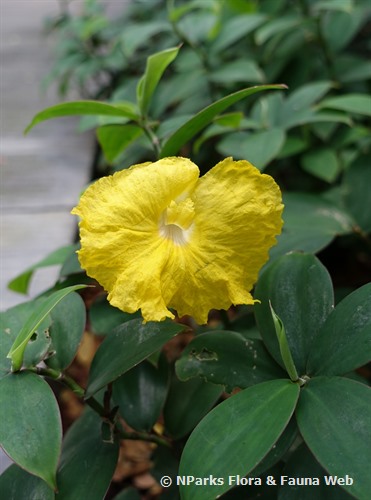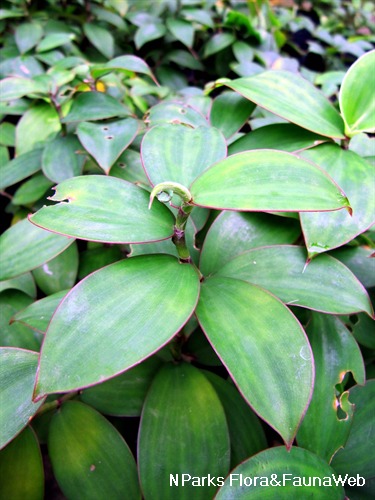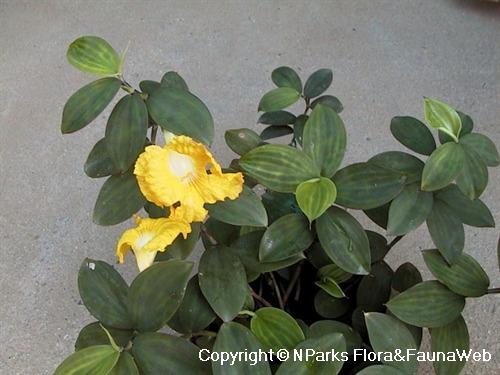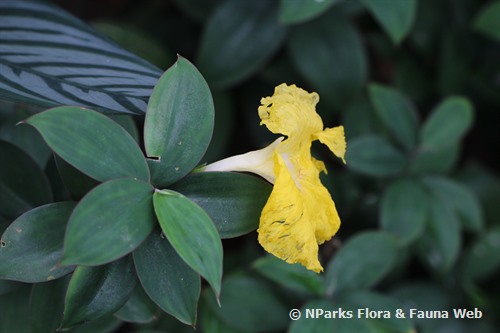-(2).jpg)
Back
Monocostus uniflorus (Poepp. ex Petersen) Maas
| Family Name: | Costaceae |
| Synonyms: | Costus uniflorus Poepp. ex Petersen, Dimerocostus uniflorus (Poepp. ex Petersen) K.Schum., Monocostus ulei K.Schum. |
| Common Name: | Lemon Ginger |
Monocostus uniflorus or Lemon Ginger is a small herbaceous plant that grows to 60 cm tall. Leaves are oblong-elliptic, dark green, leaf margin may appear red to reddish purple with hairs, spirally arranged on the curvy stems. Flowers are solitary, axillary, lipped, bright yellow with a white centre. Fruit is produced in a capsule that spilt lengthwise when ripe. Lemon Ginger is the only species found under the genus, Monocostus.
Name
Classifications and Characteristics
| Plant Division | Angiosperms (Flowering Seed Plants) (Monocotyledon) |
|---|---|
| Plant Growth Form | Herbaceous Plant |
| Mode of Nutrition | Autotrophic |
| Maximum Height | 0.6 m |
Biogeography
| Native Distribution | Eastern Peru |
|---|---|
| Native Habitat | Terrestrial (Primary Rainforest) |
| Preferred Climate Zone | Tropical |
| Local Conservation Status | Non-native |
Description and Ethnobotany
| Growth Form | It is a herb that grows to 60 cm tall, forming dense tufts of spirally curved stems with green to brown reddish leaf sheaths. |
|---|---|
| Foliage | Leaves are small, oblong-elliptic, dark green in colour, up to 8 cm long and 3.5 cm wide. Leaf margin is smooth, ciliate, red to reddish purple in colour. Foliage is spirally arranged along the stems. |
| Flowers | Flowers are borne singly, lipped, bright sulfur-yellow in colour, the centre of the flower may appear white. They are attached to a short flower stalk found on the axils of the upper leaves. |
| Fruit | Fruit is produced in a elongated capsule that splits lengthwise when ripe. Seeds are black, glossy, white aril attached. |
| Habitat | Found in the forests, between 500m - 800m altitude. |
| Taxonomy | Monocostus uniflorus belong to a monotypic genus - the sole species under its genus. |
| Cultivation | It thrives in fertile, moist, well-drained soil, sheltered from the afternoon sun. |
Landscaping Features
| Desirable Plant Features | Ornamental Flowers, Ornamental Foliage |
|---|---|
| Landscape Uses | Interiorscape/ Indoor Plant, Parks & Gardens, Small Gardens, Container Planting |
Fauna, Pollination and Dispersal
| Pollination Method(s) | Biotic (Fauna) (Insects (Bee)) |
|---|
Plant Care and Propagation
| Light Preference | Semi-Shade |
|---|---|
| Water Preference | Lots of Water, Moderate Water, Occasional Misting |
| Plant Growth Rate | Fast |
| Rootzone Tolerance | Well-Drained Soils, Fertile Loamy Soils |
| Pest(s) | Chewing Insects, Sucking Insects |
| Propagation Method | Seed, Division |
Foliar
| Foliage Retention | Evergreen |
|---|---|
| Mature Foliage Colour(s) | Green, Purple, Red |
| Mature Foliage Texture(s) | Smooth |
| Foliar Type | Simple / Unifoliate |
| Foliar Arrangement Along Stem | Spiral |
| Foliar Attachment to Stem | Petiolate |
| Foliar Shape(s) | |
| Foliar Venation | Parallel |
| Foliar Margin | Ciliate / Hairy, Entire |
| Foliar Apex - Tip | Acuminate, Cuspidate |
| Foliar Base | Rounded / Obtuse |
| Leaf Area Index (LAI) for Green Plot Ratio | 3.5 (Shrub & Groundcover - Monocot) |
Non - Foliar and Storage
| Stem Type & Modification | Herbaceous |
|---|---|
| Root Type | Underground (Fibrous Root) |
Floral (Angiosperm)
| Flower & Plant Sexuality | Bisexual Flowers , Bisexual Flowers |
| Flower Colour(s) | Yellow / Golden, White |
|---|
| Flower Texture(s) | Smooth, Thin |
| Flower Grouping | Solitary |
| Flower Location | Axillary |
| Flower Symmetry | Bilateral |
| Individual Flower Shape | Labiate / Lipped |
| Flowering Period | Free-Flowering |
| Flowering Habit | Polycarpic |
Fruit, Seed and Spore
| Fruit Classification | Simple Fruit |
|---|---|
| Fruit Type | Dehiscent Dry Fruit , Capsule |
| Mature Seed Colour(s) | Black |
| Mature Seed Texture(s) | Glossy / Shiny |
References
| References | Specht, C.D. & Stevenson, D.Wm (2006). A new phylogeny-based generic classification of Costaceae (Zingiberales). Taxon, 55(1), pp. 153-163. Royal Botanic Gardens, Kew (continuously updated). Plants of the World Online | Kew Science. https://powo.science.kew.org/taxon/urn:lsid:ipni.org:names:163776-2. Accessed 01 March 2022. |
|---|
Image Repository
Others
| Master ID | 941 |
|---|---|
| Species ID | 2235 |
| Flora Disclaimer | The information in this website has been compiled from reliable sources, such as reference works on medicinal plants. It is not a substitute for medical advice or treatment and NParks does not purport to provide any medical advice. Readers should always consult his/her physician before using or consuming a plant for medicinal purposes. |

-(3).jpg)
.jpg)
